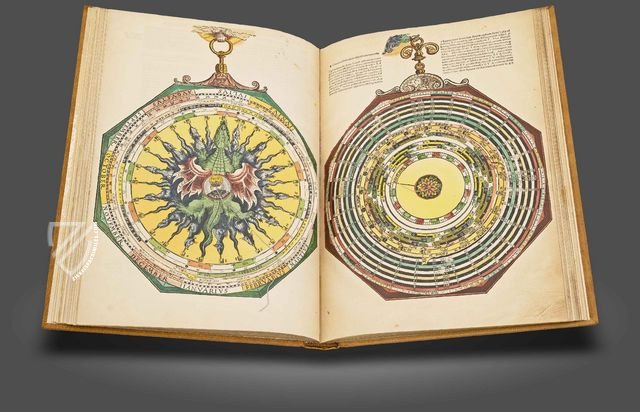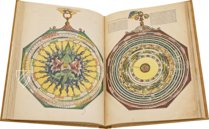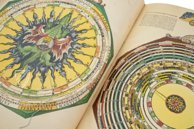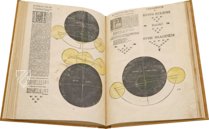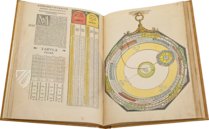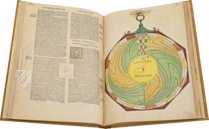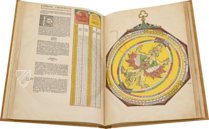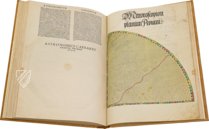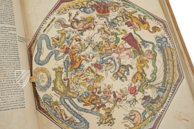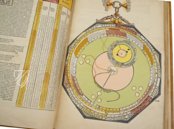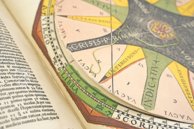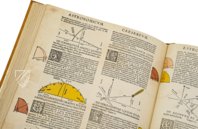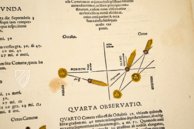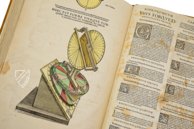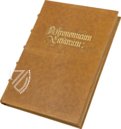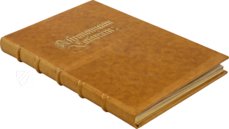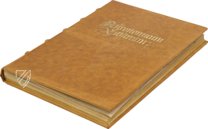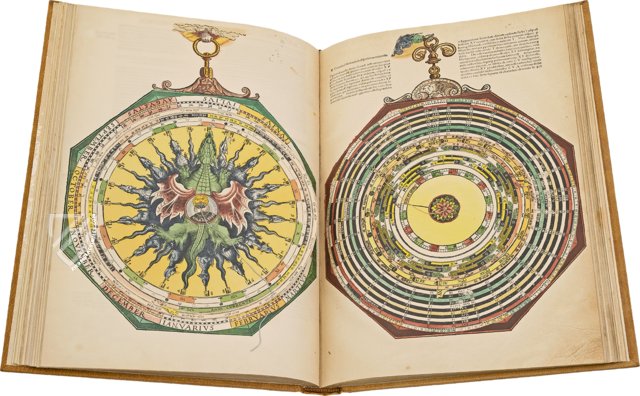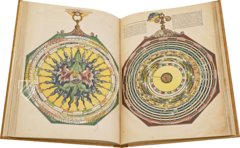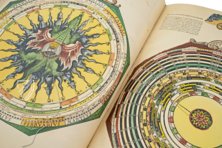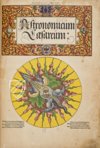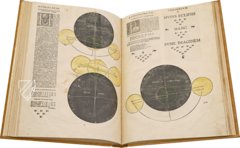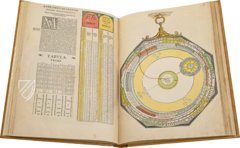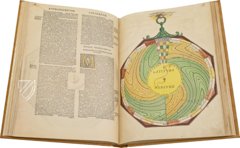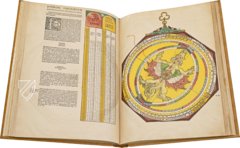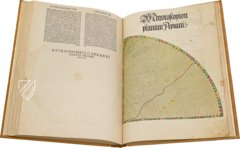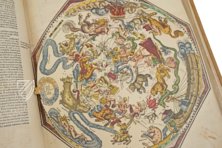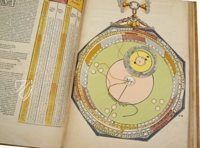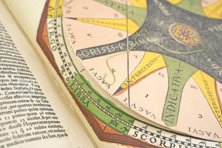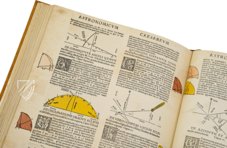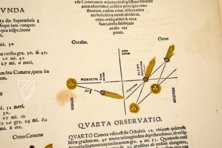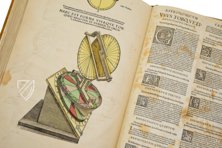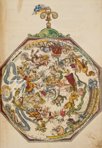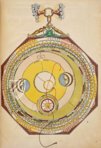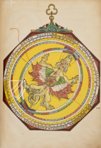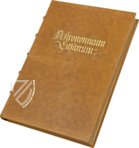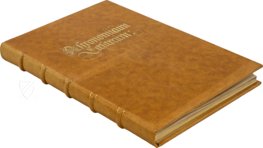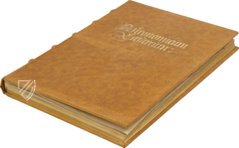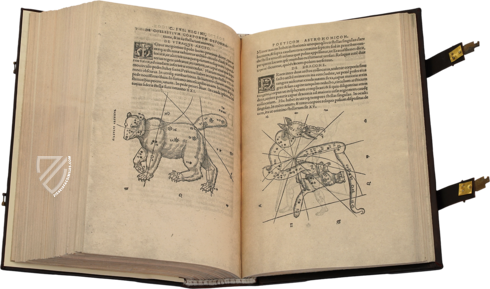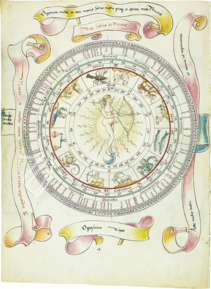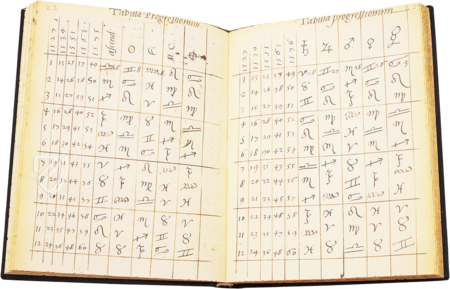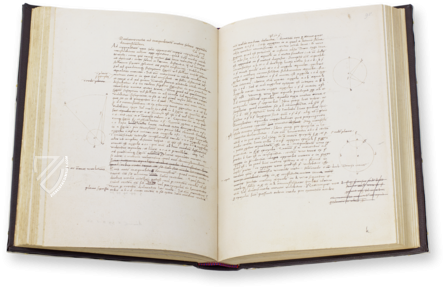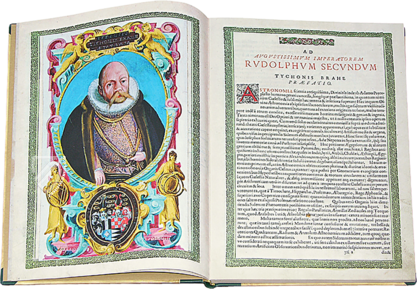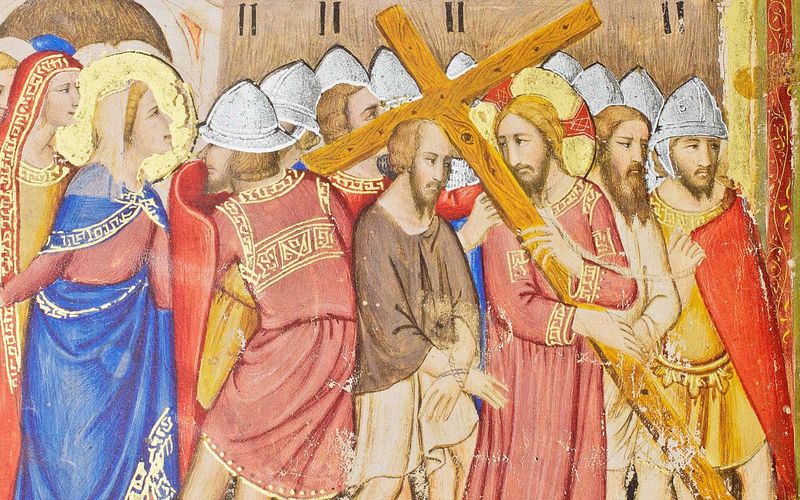Astronomicum Caesareum
(3,000€ - 7,000€)
The Astronomicum Caesareum by Peter Apian (1495–1552) is a truly magnificently adorned scientific work that wonderfully represents the state of astronomical knowledge in the mid-16th century. Apian was a leading German humanist and, as a typical Renaissance polymath, was active not only as an astronomer but also as a mathematician, cartographer, professor, and printer. Published in 1540, his work is considered the last great creation of Ptolemaic astronomy before the Copernican revolution and testifies to the state of the discipline immediately before the publication of the heliocentric theory presented by Nicolaus Copernicus (1473–1543) just three years later. 58 hand-colored woodcuts by the two masters Michael Ostendorfer (1490/94–1559) and Hans Brosamer (1494–1554) artistically illustrate the text and are complemented by 21 fascinating rotating paper discs for calculating the positions of the celestial bodies.
Astronomicum Caesareum
Also known as Petrus Apianus, Peter Apian (1495-1552) was a prominent German humanist, mathematician, astronomer, and cartographer. The author of various works, his Astronomicum Caesareum is considered by many as "perhaps the most beautiful scientific book ever printed" (Brashear, Ronald, Daniel Lewis, and Owen Gingerich. 2001.) Published in 1540, the work predated De revolutionibus orbium coelestium, the groundbreaking treatise on a heliocentric solar system by Nicolaus Copernicus (1473-1543), by only three years. The book was thus scientifically very quickly outdated for the time. Not a few astronomers of the following generations – among them Johannes Kepler (1571-1630) – therefore expressed derision concerning this work. It was not until the 20th century that this last great creation of Ptolemaic astronomy attracted the attention of researchers as well as that of bibliophile collectors.
A True Renaissance Man
Probably born Peter Bienewitz in Leisnig an der Mulde in Saxony as the son of a successful shoemaker, he studied at the universities of Leipzig and Vienna. Since the imperial court had a keen interest in astrology and astronomy, the University of Vienna had long been a center for the study of astronomy as well as geography and mathematics. From Vienna, Apian went to Regensburg and then Landshut in 1523, eventually teaching mathematics at University of Ingolstadt from 1526 until his death in 1552. However, applied mathematics – astronomy and geodesy – were not particularly popular subjects there and mainly medical students attended Apian's lectures on astronomy. Physicians needed basic astronomical knowledge, for example in connection with bloodletting therapy, in order to determine the ideal times for their interventions.
One of the Original Self-Publishers
At the same time, he ran a print shop in Ingolstadt together with his brother Georg. There, in addition to Peter Apian's own works, they mainly printed those of Johann Eck (1486-1543), a fellow professor and most important theological opponent to Martin Luther (1483-1546). By operating the print shop, Apian did not merely want to tap additional sources of income, but above all to make himself independent of outside printers. In order to avoid errors in the printing of their works, which were difficult to typeset, quite a few famous astronomers in the early modern era – such as Tycho Brahe (1546-1601) or Johannes Hevelius (1611-87) – operated their own printing workshops. Apian's first significant astronomical publication was the Instrument Book, printed in 1533, in which he describes scientific instruments that served astronomers, surveyors, and navigators alike.
A Masterpiece of Science and Printing
Printed in 1540, the large-format Astronomicum Caesareum is a magnificent masterpiece of 16th-century book art that took eight years to complete. The number of printed copies is unknown. However, 111 copies have survived to this day, 34 of which are in Germany. The hand coloring was already done in Apian's workshop, which was rather unusual at that time. After the publication of the Astronomicum Caesareum, Apian's print shop largely ceased its work and was sold after his death. Apian dedicated the work to Emperor Charles V (1500-58) and his brother Emperor Ferdinand I (1503-64), who both financed the printing and made the author a rich man. Moreover, the book earned him the title of court mathematician and elevation to the peerage.
Encyclopedia of the Stars
The Astronomicum Caesareum summarizes the state of astronomical knowledge in the mid-16th century. In the foreground of the first part is the representation of the planetary movements and the determination of the position of the celestial bodies, which made the work interesting not least for astrologers. The movements of the celestial bodies are illustrated with the help of 21 rotating discs made of paper, the so-called volvelles. The Astronomicum Caesareum is thus not only a theoretical astronomy book, but at the same time a scientific instrument with which the position of the sun, moon and planets can be determined. Such rotating representations can already be found in Apian’s earlier writings and are part of a tradition going back to the 15th century. In total, the work includes 58 hand-colored woodcuts created by Michael Ostendorfer (1490/94-1559) and Hans Brosamer (1494-1554). The introductory celestial map lists the 1,022 stars known to Apian and the second part of the work deals with astronomical instruments and comets. Apian, by the way, was the first to recognize that the tail of a comet always faces away from the Sun.
Codicology
- Alternative Titles
- Peter Apian: Astronomicum Caesareum
Petrus Apianus: Astronomicum Caesareum - Size / Format
- 120 pages / 45.5 × 32.5 cm
- Origin
- Germany
- Date
- 1540
- Epochs
- Style
- Genre
- Illustrations
- Numerous woodcuts
- Content
- Astronomical treatises with numerous volvelles
- Patron
- Emperor Charles V (1500–1558)
Ferdinand I (1503–1564) - Artist / School
- Petrus Apianus (author)
Astronomicum Caesareum
A Kaleidoscope of Constellations
Several charts of the cosmos present an artistic tangle of zodiac symbols and other constellations, which are presented in the form of the mythological character(s) with which they are associated. As such, Hercules, greatest of all the heroes, is depicted in battle with the Nemean Lion at the center of this page alongside the constellation Opiuchus, which is represented by a man fighting a great serpent. Libra, Scorpio, and Sagittarius appear on the circle labelled ECPLIPTICA along with the rest of the zodiac symbols.
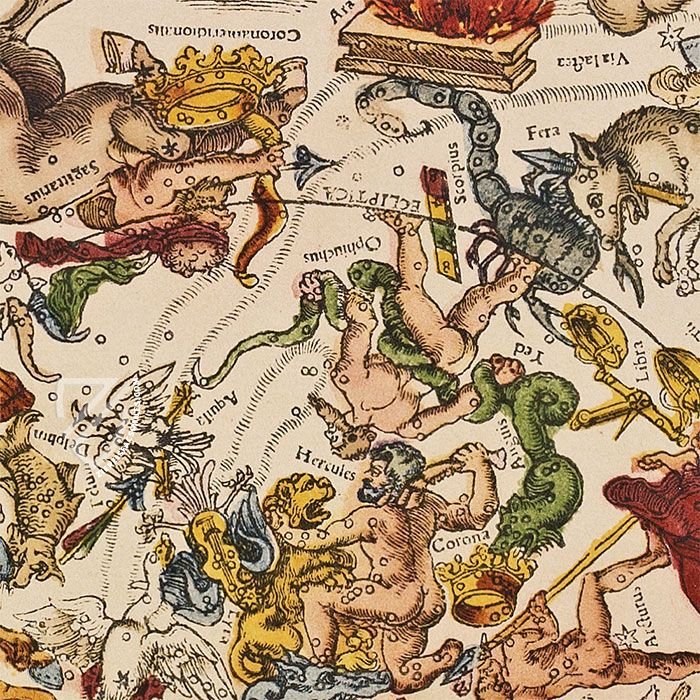
Astronomicum Caesareum
Volvelle
This work is a wonderful blend of science and art that features 21 beautifully designed volvelles, a type of paper slide chart with rotating parts that is used for making calculations like an analog computer. Although they were based on the false geocentric model of the universe, they could still be used reliably for predicting the movements of the planets.
The outer ring of this volvelle is labelled with the names of the twelve zodiac signs, and as such it can be assumed that this chart was used for calculating horoscopes based on an exact calculation of the time of one’s birth. Astronomy and astrology were still closely intertwined during the 16th century, which is creatively illustrated by this brightly colored volvelle with a muscular, curly-tailed dragon.
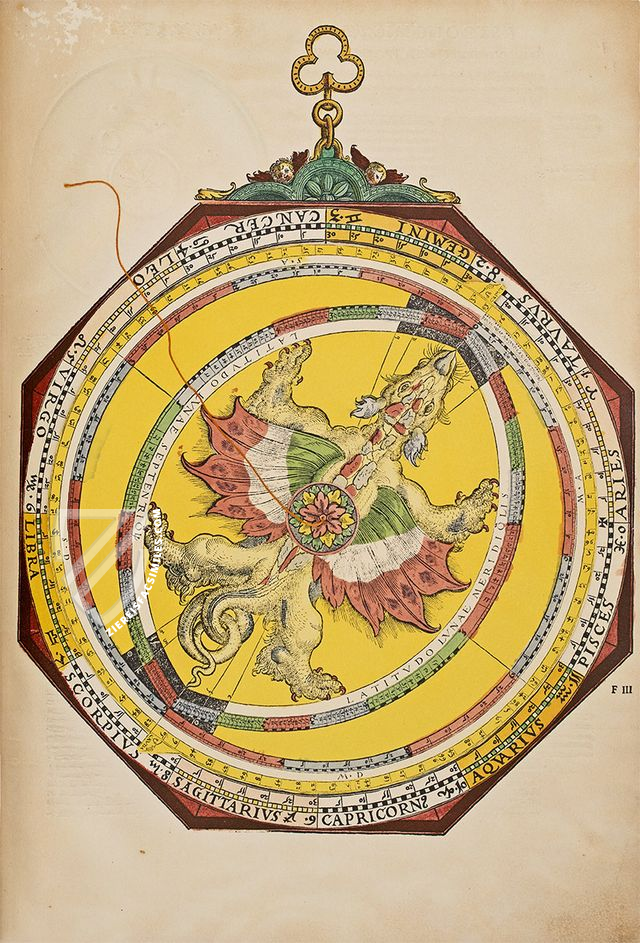
#1 Astronomicum Caesareum
Languages: German, English
(3,000€ - 7,000€)
- Treatises / Secular Books
- Apocalypses / Beatus
- Astronomy / Astrology
- Bestiaries
- Bibles / Gospels
- Chronicles / History / Law
- Geography / Maps
- Saints' Lives
- Islam / Oriental
- Judaism / Hebrew
- Single Leaf Collections
- Leonardo da Vinci
- Literature / Poetry
- Liturgical Manuscripts
- Medicine / Botany / Alchemy
- Music
- Mythology / Prophecies
- Psalters
- Other Religious Books
- Games / Hunting
- Private Devotion Books
- Other Genres
- Afghanistan
- Armenia
- Austria
- Belgium
- Belize
- Bosnia and Herzegovina
- China
- Colombia
- Costa Rica
- Croatia
- Cyprus
- Czech Republic
- Denmark
- Egypt
- El Salvador
- Ethiopia
- France
- Germany
- Greece
- Guatemala
- Honduras
- Hungary
- India
- Iran
- Iraq
- Israel
- Italy
- Japan
- Jordan
- Kazakhstan
- Kyrgyzstan
- Lebanon
- Liechtenstein
- Luxembourg
- Mexico
- Morocco
- Netherlands
- Palestine
- Panama
- Peru
- Poland
- Portugal
- Romania
- Russia
- Serbia
- Spain
- Sri Lanka
- Sweden
- Switzerland
- Syria
- Tajikistan
- Turkey
- Turkmenistan
- Ukraine
- United Kingdom
- United States
- Uzbekistan
- Vatican City
- A. Oosthoek, van Holkema & Warendorf
- Aboca Museum
- Ajuntament de Valencia
- Akademie Verlag
- Akademische Druck- u. Verlagsanstalt (ADEVA)
- Aldo Ausilio Editore - Bottega d’Erasmo
- Alecto Historical Editions
- Alkuin Verlag
- Almqvist & Wiksell
- Amilcare Pizzi
- Andreas & Andreas Verlagsbuchhandlung
- Archa 90
- Archiv Verlag
- Archivi Edizioni
- Arnold Verlag
- ARS
- Ars Magna
- ArtCodex
- AyN Ediciones
- Azimuth Editions
- Badenia Verlag
- Bärenreiter-Verlag
- Belser Verlag
- Belser Verlag / WK Wertkontor
- Benziger Verlag
- Bernardinum Wydawnictwo
- BiblioGemma
- Biblioteca Apostolica Vaticana (Vaticanstadt, Vaticanstadt)
- Bibliotheca Palatina Faksimile Verlag
- Bibliotheca Rara
- Boydell & Brewer
- Bramante Edizioni
- Bredius Genootschap
- Brepols Publishers
- British Library
- C. Weckesser
- Caixa Catalunya
- Canesi
- CAPSA, Ars Scriptoria
- Caratzas Brothers, Publishers
- Carus Verlag
- Casamassima Libri
- Centrum Cartographie Verlag GmbH
- Chavane Verlag
- Christian Brandstätter Verlag
- Circulo Cientifico
- Club Bibliófilo Versol
- Club du Livre
- CM Editores
- Collegium Graphicum
- Collezione Apocrifa Da Vinci
- Comissão Nacional para as Comemorações dos Descobrimentos Portugueses
- Coron Verlag
- Corvina
- CTHS
- D. S. Brewer
- Damon
- De Agostini/UTET
- De Nederlandsche Boekhandel
- De Schutter
- Deuschle & Stemmle
- Deutscher Verlag für Kunstwissenschaft
- DIAMM
- Droz
- E. Schreiber Graphische Kunstanstalten
- Ediciones Boreal
- Ediciones Grial
- Ediclube
- Edições Inapa
- Edilan
- Editalia
- Edition Deuschle
- Edition Georg Popp
- Edition Leipzig
- Edition Libri Illustri
- Editiones Reales Sitios S. L.
- Éditions de l'Oiseau Lyre
- Editions Medicina Rara
- Editorial Casariego
- Editorial Mintzoa
- Editrice Antenore
- Editrice Velar
- Edizioni Edison
- Egeria, S.L.
- Eikon Editores
- Electa
- Emery Walker Limited
- Enciclopèdia Catalana
- Eos-Verlag
- Ephesus Publishing
- Ernst Battenberg
- Eugrammia Press
- Extraordinary Editions
- Fackelverlag
- Facsimila Art & Edition
- Facsimile Editions Ltd.
- Facsimilia Art & Edition Ebert KG
- Faksimile Verlag
- Feuermann Verlag
- Folger Shakespeare Library
- Franco Cosimo Panini Editore
- Friedrich Wittig Verlag
- Fundación Hullera Vasco-Leonesa
- G. Braziller
- Gabriele Mazzotta Editore
- Gebr. Mann Verlag
- Gesellschaft für graphische Industrie
- Getty Research Institute
- Giovanni Domenico de Rossi
- Giunti Editore
- Graffiti
- Grafica European Center of Fine Arts
- Guido Pressler
- Guillermo Blazquez
- Gustav Kiepenheuer
- H. N. Abrams
- Harrassowitz
- Harvard University Press
- Helikon
- Hendrickson Publishers
- Henning Oppermann
- Herder Verlag
- Hes & De Graaf Publishers
- Hoepli
- Holbein-Verlag
- Houghton Library
- Hugo Schmidt Verlag
- Idion Verlag
- Il Bulino, edizioni d'arte
- ILte
- Imago
- Insel Verlag
- Insel-Verlag Anton Kippenberger
- Instituto de Estudios Altoaragoneses
- Instituto Nacional de Antropología e Historia
- Introligatornia Budnik Jerzy
- Istituto dell'Enciclopedia Italiana - Treccani
- Istituto Ellenico di Studi Bizantini e Postbizantini
- Istituto Geografico De Agostini
- Istituto Poligrafico e Zecca dello Stato
- Italarte Art Establishments
- Jan Thorbecke Verlag
- Johnson Reprint Corporation
- Josef Stocker
- Josef Stocker-Schmid
- Jugoslavija
- Karl W. Hiersemann
- Kasper Straube
- Kaydeda Ediciones
- Kindler Verlag / Coron Verlag
- Kodansha International Ltd.
- Konrad Kölbl Verlag
- Kurt Wolff Verlag
- La Liberia dello Stato
- La Linea Editrice
- La Meta Editore
- Lambert Schneider
- Landeskreditbank Baden-Württemberg
- Leo S. Olschki
- Les Incunables
- Liber Artis
- Library of Congress
- Libreria Musicale Italiana
- Lichtdruck
- Lito Immagine Editore
- Lumen Artis
- Lund Humphries
- M. Moleiro Editor
- Maison des Sciences de l'homme et de la société de Poitiers
- Manuscriptum
- Martinus Nijhoff
- Maruzen-Yushodo Co. Ltd.
- MASA
- Massada Publishers
- McGraw-Hill
- Metropolitan Museum of Art
- Militos
- Millennium Liber
- Müller & Schindler
- Nahar - Stavit
- Nahar and Steimatzky
- National Library of Wales
- Neri Pozza
- Nova Charta
- Oceanum Verlag
- Odeon
- Orbis Mediaevalis
- Orbis Pictus
- Österreichische Staatsdruckerei
- Oxford University Press
- Pageant Books
- Parzellers Buchverlag
- Patrimonio Ediciones
- Pattloch Verlag
- PIAF
- Pieper Verlag
- Plon-Nourrit et cie
- Poligrafiche Bolis
- Presses Universitaires de Strasbourg
- Prestel Verlag
- Princeton University Press
- Prisma Verlag
- Priuli & Verlucca, editori
- Pro Sport Verlag
- Propyläen Verlag
- Pytheas Books
- Quaternio Verlag Luzern
- Reales Sitios
- Recht-Verlag
- Reichert Verlag
- Reichsdruckerei
- Reprint Verlag
- Riehn & Reusch
- Roberto Vattori Editore
- Rosenkilde and Bagger
- Roxburghe Club
- Salerno Editrice
- Saltellus Press
- Sandoz
- Sarajevo Svjetlost
- Schöck ArtPrint Kft.
- Schulsinger Brothers
- Scolar Press
- Scrinium
- Scripta Maneant
- Scriptorium
- Shazar
- Siloé, arte y bibliofilia
- SISMEL - Edizioni del Galluzzo
- Sociedad Mexicana de Antropología
- Société des Bibliophiles & Iconophiles de Belgique
- Soncin Publishing
- Sorli Ediciones
- Stainer and Bell
- Studer
- Styria Verlag
- Sumptibus Pragopress
- Szegedi Tudomànyegyetem
- Taberna Libraria
- Tarshish Books
- Taschen
- Tempus Libri
- Testimonio Compañía Editorial
- Thames and Hudson
- The Clear Vue Publishing Partnership Limited
- The Facsimile Codex
- The Folio Society
- The Marquess of Normanby
- The Richard III and Yorkist History Trust
- Tip.Le.Co
- TouchArt
- TREC Publishing House
- TRI Publishing Co.
- Trident Editore
- Tuliba Collection
- Typis Regiae Officinae Polygraphicae
- Union Verlag Berlin
- Universidad de Granada
- University of California Press
- University of Chicago Press
- Urs Graf
- Vallecchi
- Van Wijnen
- VCH, Acta Humaniora
- VDI Verlag
- VEB Deutscher Verlag für Musik
- Verlag Anton Pustet / Andreas Verlag
- Verlag Bibliophile Drucke Josef Stocker
- Verlag der Münchner Drucke
- Verlag für Regionalgeschichte
- Verlag Styria
- Vicent Garcia Editores
- W. Turnowski Ltd.
- W. Turnowsky
- Waanders Printers
- Wiener Mechitharisten-Congregation (Wien, Österreich)
- Wissenschaftliche Buchgesellschaft
- Wissenschaftliche Verlagsgesellschaft
- Wydawnictwo Dolnoslaskie
- Xuntanza Editorial
- Zakład Narodowy
- Zollikofer AG

